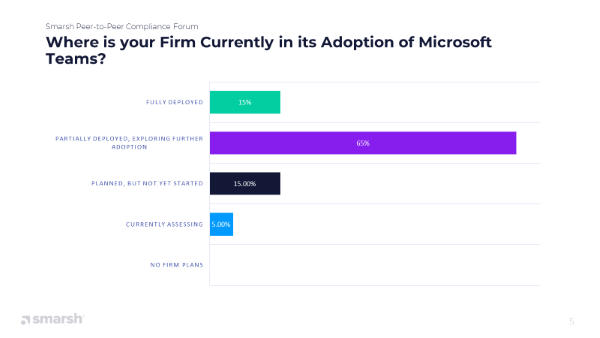Overcoming Challenges to the Successful Adoption of Microsoft Teams
In the world of technology, rarely do we see a convergence of forces that lead to the massive adoption recently experienced by Microsoft Teams and Zoom. A disrupted market, meaningful technology innovation, and a lack of reasonably comparable alternatives rarely find themselves at the same place, at the same time.
The year of workplace communication with Microsoft Teams
To explore Microsoft Teams more deeply, there are several unique aspects that we’d like to unpack. First is the fact that the pandemic has basically accelerated us down a road we were already traveling on. At the beginning of 2020, Teams was already established as the most successful product launch in Microsoft history with over 75 million daily active users, and over 200 million meeting participants in a single day.
The reasons behind the success were clear. Teams provides the utility of a unified, multi-function environment that can serve as a hub for chat, meetings, calls and collaboration. It is coupled with an ability to work seamlessly with other Microsoft business productivity tools inside the Microsoft Office 365 suite. For many firms, the decision to standardize on Teams and Office 365 as part of their overriding IT cloud strategy was less of an if discussion, and instead more of a conversation about how and when.
Unique challenges of migrating to a new collaboration tool
Additionally, for a lot of firms, the move to Teams was not their first migration from one generation of Microsoft collaborative technology to the next. Moving from MCS to OCS, OCS to Lync, or Lync to Skype for Business had all brought unique challenges: new features, the lack of available technology controls, or the need to guide employees through the use of early-stage releases.
As a result, many firms have chosen an incremental roll-out strategy. They limit the first deployment phases to controlled sub-groups of IT or business users until they have rolled out policy updates and training programs, and implemented automated controls suitable for larger deployments. We have seen this quite frequently. Initial deployment pools are expanded over time to incorporate non-regulated users, new geographic entities, and other groups.
Compliant adoption of Microsoft Teams
Another aspect is the nature of collaborative technology itself. With the objective of using Teams as the hub for work, firms need to be prepared for meeting rooms with hundreds of participants. These often feature a mix of regulated and non-regulated users, subject to different policy controls. Automation for some of these controls may not yet be available. Sometimes these threads may include individuals whose content is not archived by the firm.
As we have transitioned into a work-from-home posture where virtually everyone is living in Teams, managing successful adoption of collaborative technology — while managing compliance and governance obligations — has taken on a level of complexity that has increased by orders of magnitude.
Fortunately, Smarsh has cultivated relationships with organizations on various stages of this journey, where early adopters can share their experiences and best practices with firms who are still in earlier planning phases. We also found a good cross-section of firms in different phases of their journey toward adoption. We brought a group of these practitioners together recently to share their perspectives on how to achieve the successful adoption of Microsoft Teams.
A peer-to-peer poll showed that over half of the respondents have only partially deployed. This implies that the initial rollouts have produced the desired benefits, resulting in increased demand. It also suggests that firms have had to look at expanded rollouts due to COVID-19.

The group also listed necessary areas of focus in the deployment and adoption processes and gave creative ideas for managing common challenges.
Challenges and Best Practices
1. Assessing new Teams capabilities
Challenge: Difficult to stay on top of a steady stream of new Teams capabilities
Best practices:
- Follow the product blogs and monitor the RSS feeds for Microsoft rollouts, so everyone has an idea of what's coming out
- Know what is coming up so you can put policies in place before end-users download or take unapproved action
- Continually reassess functionality; conduct rigorous testing and risk acceptance practices
2. Teams rollout
Challenges:
- Understanding the impact of changes to underlying systems (e.g., group membership, links vs. attachments)
- New Teams features often defaulted on
- Some are finding inconsistencies; Teams creates a record in some cases, not in others (i.e., an internal person joins an external Team meeting)
Best Practices:
- Set up a steering committee with stakeholders from compliance and legal departments to work with the IT teams on the new rollout
- Use steering committee to build a plan to react to new Teams releases
- Take a methodical and cautious approach to rollout and minimize trial and error
- Ensure that your firm understands the entire Microsoft 365 suite and not just one component (like Teams)
- Build and follow checklists to guide incremental rollouts
3. Change management
Challenge: How will you move from deployment to full-scale adoption?
Best practices:
- Training must include policies, procedures and technology controls
- Plan for the end game: one firm plans to start and track all conversations in Teams to reduce meetings
4. Employee training
Challenges:
- Initial deployments can be driven by sub-groups (like IT), then followed with other groups without proper training
- Some users are not technical, and won't invest time to learn new features
Best Practices:
- Training should be extensive, role-specific, and targeted to new Teams features
- Practice over-communication to minimize self-training burden on users
- Adjust supervisory policies for regulated users on Teams, and consider periodic inspections of non-regulated users to identify potential policy infractions
5. Policy controls
Challenge: New Teams features are often released before the availability of technology policy controls
Best practices:
- "Trust but verify" is a good strategy if relying solely upon individual actions, but should be complemented with periodic inspection
- Absent available technology controls, firms should invest in policies and procedures to ensure that employees know what they can and cannot do
- Define policies for regulated and non-regulated users
- An emerging tactic is to split employees into two groups, and either turn off capabilities or define prohibition policies for regulated users
6. Regulatory guidance
Challenge: Unclear guidance from regulators (to date) on how firms should be capturing and supervising new capabilities such as whiteboards and voice recordings
Best practices:
- FINRA & SEC have published guidance and FAQs on expectations of how firms can monitor tech being used during the pandemic
- Regulators are spot-checking the use of new features
- Must retain new capabilities if they are being used by regulated individuals; it is a different decision to determine if they constitute a record for non-regulated users
Share this post!
Smarsh Blog
Our internal subject matter experts and our network of external industry experts are featured with insights into the technology and industry trends that affect your electronic communications compliance initiatives. Sign up to benefit from their deep understanding, tips and best practices regarding how your company can manage compliance risk while unlocking the business value of your communications data.





Subscribe to the Smarsh Blog Digest
Subscribe to receive a monthly digest of articles exploring regulatory updates, news, trends and best practices in electronic communications capture and archiving.
Smarsh handles information you submit to Smarsh in accordance with its Privacy Policy. By clicking "submit", you consent to Smarsh processing your information and storing it in accordance with the Privacy Policy and agree to receive communications from Smarsh and its third-party partners regarding products and services that may be of interest to you. You may withdraw your consent at any time by emailing privacy@smarsh.com.
FOLLOW US